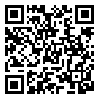BibTeX | RIS | EndNote | Medlars | ProCite | Reference Manager | RefWorks
Send citation to:
URL: http://rehabilitationj.uswr.ac.ir/article-1-391-en.html

 , Seyed Mahmoud Mirzamani2
, Seyed Mahmoud Mirzamani2 
 , Abbas Davarmanesh2
, Abbas Davarmanesh2 
 , Masoud Salehi3
, Masoud Salehi3 
 , Omid Massah-Choolaby4
, Omid Massah-Choolaby4 
 , Mahboubeh Hashemi5
, Mahboubeh Hashemi5 
 , Avisheh Gholami6
, Avisheh Gholami6 

2- University of Welfare & Rehabilitation Sciences
3- Iran university
4- University of Social Welfare and rehabilitation sciences
5- University of Social Welfare and rehabilitation sciences, Pediatric Neurorehabilitation Research Center
6- Islamic Azad University, Karaj Branch
Objective: Aggression behavior is a common problem among mentally retarded people. Art therapy is one of the methods suggested for treatment of aggression. Therefore the aim of present research is investigating the effect of painting on decreasing of aggression in educable mentally retarded girl students in elementary course in Karaj Township.
Materials & Methods: In this research which is an interventional study from the type of Quasi-experimental with pre and post-test with control and experimental groups, 52 educable mentally retarded girls' students in elementary course in Karaj township, after considering standards entrance to study, with using of cluster multistage sampling, were selected for participating in research. For assessment of aggression rate of students, Aggression test of mentally retarded children (B.D.Gh) was used. After extraction of pre-test results, considering to educational levels, age and aggression rate, students were located into two similar groups and by accident one group was selected as control group and the other one as experimental group. Then, experimental group painted in 8 continuous sessions according to procedure. After 10 days of last session, aggression questionnaire was performed as post-test to define that if this method was effective on decreasing of aggression or not? Data was analyzed by using of independent and paired T-test, Kolmogrov-Smirnov test, one-way ANOVA and Post Hoc Tokey test.
Results: The results showed that there's significant different between the average scores of pre and post-tests of total aggression, nonverbal aggression to self, verbal aggression to others and nonverbal aggression to others of experimental group in comparison with control group (P<0.001) but there's not significant different between the average scores of pre and post-tests of verbal aggression to self (P>0.001). Also results showed that there's significant difference between aggression of different age groups in pre-test (P=0.01) and post-tests (P=0.03). So, Post Hoc Tokey test was used. The results showed that age groups 11-12 years old have had less aggression average than age groups 14-15 years old in pre-test situation.
Conclusion: Painting is effective on decreasing of aggression in educable mentally retarded girl students in elementary course.
Received: 8/01/2010 | Accepted: 6/01/2014 | Published: 6/01/2014
| Rights and permissions | |
 |
This work is licensed under a Creative Commons Attribution-NonCommercial 4.0 International License. |



